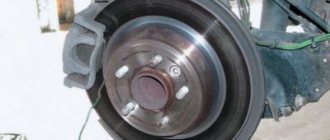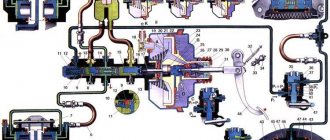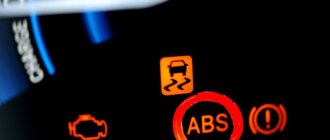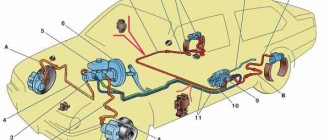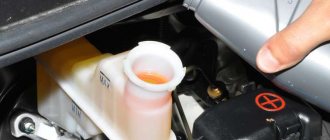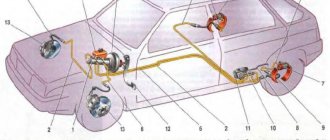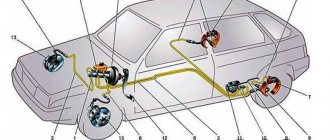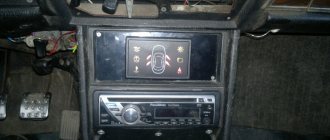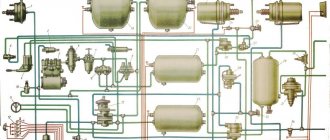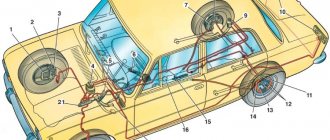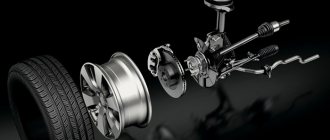Sensor types
There are two types of sensors on cars:
- passive sensor built on the basis of a coil;
- active sensor that uses the Hall effect.
The passive sensor turns on after the start of movement and reads data from the toothed pulse ring. The passage of a tooth past the device causes the generation of a current pulse, which is read by the control unit. The sensors start working at speeds above 5 km/h and do not respond to contamination.
The active sensor consists of electronic components and a permanent magnet, which is mounted on the hub. When the magnet rotates in the device, a potential difference arises, which is formed into a microcircuit control signal. The information is then sent to the block. Sensors of this design are rare and cannot be repaired.
ABS sensors
Some speed sensors operate on a principle based on the magnetoresistive effect. Others use the Hall effect. There are passive and active varieties.
Passive sensors are large in size and begin to record readings only when they reach 5–7 km/h. They are less susceptible to wear, and contamination does not interfere (due to the design).
Active analogs appeared at the end of the last century, in the 90s. The work is based on the properties of semiconductor diodes, which change the direction of current under the influence of a magnetic field. These are magnetoresistive sensors. There are Hall sensors based on the phenomenon of current generation in resistance placed in a magnetic field.
In both cases, the source of the magnetic field (ring) is fixed to the hub and moves with it. In the first case, changes in the field cause the electrons to change direction, changing the corresponding resistance value. This is transmitted to the ECU.
In the second option, a changing magnetic field moves electrons to one end of the conductor, creating a constant voltage that is transmitted to the ECU. A significant disadvantage is the susceptibility to interference.
Factors that provoke various problems in sensors:
— weak resistance of the magnetic field to various interferences
— the installation location contributes to severe contamination
- mechanical influence of wheel movement - vibrations, vibrations, shocks, etc.
Anti-lock braking system (ABS). Description
A car's Anti-lock Braking System is a system that regulates the brake fluid pressure in the brake circuits, which helps prevent the wheels from locking during braking. In other words, this system prevents skidding, which provides the following benefits:
- Increasing vehicle stability.
- Reducing braking distance.
- Saving rubber and preserving the studs on car tires.
In addition to its primary function, anti-lock braking system sensors and valves are used for many other vehicle systems. For example, exchange rate stability system or emergency braking assistance system. The stability control system brakes certain wheels during sharp turns or drifts, which significantly improves safety performance. Brake Assist keeps the brake pedal depressed until the vehicle comes to a complete stop.
Varieties of design
To calculate the angular speed of wheel rotation, 2 types of ABS sensor devices can be used:
- based on an inductive element. They are also called passive, since the sensitive element does not require external power, and the operating principle itself is based on the effect of electromagnetic induction. Despite the simplicity of design and reliability, such devices are becoming less and less common on modern cars. The main drawback of the design is that at low vehicle speeds it is impossible to adequately calculate the wheel speed;
- sensors based on the Hall effect. They are also called active, since the sensitive element needs power - a reference voltage. The signal produced by such speed sensors allows the ECU to more accurately calculate the wheel speed.
How to find out what's wrong with the anti-lock braking system?
Before the appearance of ABS systems in cars in the 70s of the 20th century, they were less safe when compared with today's modern cars. This was especially true when the driver had to move either on a wet or snowy icy road. In those years, old cars were usually equipped with not very high-quality wheels (tires), not entirely reliable rear-wheel drive, as well as a conventional and simple braking system without any electronics. But today, as you know friends, everything has changed for the better. Nowadays, most drivers don’t even think about the modern brake systems on their cars. Today, each of us (drivers) feels confident and reliable behind the wheel of a car, even when driving on a road that is covered with several centimeters of snow or is completely icy. It's all about the following. Most modern cars these days are equipped with front-wheel drive, which gives drivers confidence when driving a car. And what’s more, these cars are also equipped with the latest modern electronic safety systems that control the car’s grip on the road surface, and excellent modern tires that demonstrate some miracles of grip on a slippery road. One of the most important systems in any modern car today is the anti-lock braking system (ABS), which significantly reduces the stopping distance of the car and prevents wheel locking, which can lead to loss of traction and, accordingly, further skidding.
See also: How to stop a car in the snow with ABS
The ABS system has become standard equipment in the automotive industry; these days it is installed on virtually every modern car produced by automobile companies. As we have written more than once, this “ABS” system consists of several parts, namely, speed sensors that are installed specifically on the wheels of the car, an electronic control unit for the anti-lock braking system and also hydraulic valves, which, according to a certain signal from the electronic unit, are here - they regulate a certain braking force in each wheel without resorting to the help of the driver (without his participation).
ABS wheel sensors monitor the rotation speed of each wheel of the car and constantly transmit data to the car computer. As soon as the ABS system unit begins to notice (see) that the wheel stops rotating, it immediately activates the valves of the hydraulic brake system and it, in turn, immediately begins to reduce the brake pressure in this very wheel. As a result, the brake fluid pressure in the wheel immediately drops and the braking force is reduced, which further helps to unlock the wheel and regain traction. This process is repeated through the car’s computer several times per second until the car comes to a complete stop or the driver releases the brake pedal.
The ABS control unit and the car computer automatically perform a self-test of the anti-lock braking system every time the ignition is turned on. That is, every time you start the car, an automatic test of the ABS system immediately occurs. If during self-testing the car computer does not receive enough data from the sensors, from the ABS control unit and from the hydraulic valves of the brake system, then a warning light with the “ABS” icon lights up on the car’s dashboard. For example, let’s say if the car’s computer or the same “ABS” control unit did not receive a return signal from the hydraulic pump of the brake system or from the same valve installed on each wheel, then the “ABS error” signal will immediately light up on the instrument panel (on the panel), - in the form of an icon (indicator).
Friends, draw your attention specifically to this, namely, despite the malfunction of the “ABS” system and the appearance on the dashboard of its burning “ABS signal-icon” in the car itself, as a rule, the mechanical braking system still continues to work and you can safely without fear of continuing to drive the car, but without this electronic system to help lock the wheels during braking. That is, in other words, we can say that if the ABS system breaks down, you can safely use your car. True, in this case you need to be extremely careful when braking on a wet, snowy or slippery road, since without this ABS system, your car’s wheels may periodically lock. Therefore, friends, we do not recommend that if the ABS system malfunctions, you operate your car without appropriate repairs for a long time. Thus, all drivers should understand that if the car computer issues an “ABS system error,” it is necessary to establish the cause of this malfunction as soon as possible and eliminate it as soon as possible.
How the anti-lock braking system works
How to diagnose ABS yourself? — to answer this question with confidence, it is important to know the structure of the system itself. To do this, let’s look at several individual parts of it:
- Speed sensors. Sensors are located near each wheel of the car. They transmit information about the rotation speed of each wheel to the ABS control unit.
- ABS control unit. The control unit receives signals from speed sensors, analyzes the situation, and, in the event of a wheel lock, transmits a command to the hydraulic control unit.
- The hydraulic control unit, having received a signal about a blocked wheel, closes the brake fluid channel going to this wheel.
The result is that as soon as the wheel is locked, the system “releases” it. Once this happens, it is blocked again. All this happens with high frequency, and as a result, the wheels rotate at maximum effort, but without switching to skidding.
How does ABS affect stopping distance?
How does ABS braking distance change?
There is often a misconception about how the operation of anti-lock brakes affects the braking distance. Many drivers hope that this system not only allows them to avoid obstacles, but also reduce the braking distance.
The main task of the ABS system is to maintain vehicle controllability, and not to reduce braking distance! That is, the braking distance from pressing the pedal to a complete stop, in most cases, will not become less
, even on the contrary, can often
increase
. Everything will depend on the road surface (wet, dry, gravel, primer, ice or slush), as well as the type of tire (summer, winter studded or Velcro). The type and configuration of the system itself also affects the braking distance.
Intermittent pressing of the brake pads to the disc will allow the wheel to spin, making it possible to change the trajectory when turning the steering wheel. In this case, the car can turn, and will not skid due to inertia, as happens with traditional emergency braking.
What does braking look like for a car with and without ABS?
So, on average, you can focus on the following indicators:
- Dry asphalt - there is no gain in distance in either case at low speeds, but when the speed limit is violated, then ABS brakes have a 15% advantage.
- Paving stones, bumps - braking without an additional system is 10% more effective.
- Dirt, gravel and slush - you can stop faster without ABS.
- Icy road - when the anti-lock system is activated, the braking distance will be reduced significantly.
However, in any of these cases, the advantage of ABS brakes is that you will be able to go around an obstacle and not wear out the rubber, and with the braking distance, how it turns out, everything will depend on the setting and type of operation of the anti-lock braking system, as well as the skills of the driver himself.
| Braking distance table with and without abs (winter/summer) at a speed of 60 km/h | ||
| Road surface | Braking distance with ABS, meters | Braking distance without ABS, meters |
| Dry asphalt road | 10 | 10 |
| Wet asphalt | 35 | 30 |
| The road is paved with paving stones | 16,5 | 15 |
| Dirt, gravel or snow slush | 25 | 19,5 |
| Packed snow/ice | 51 | 56 |
As the speed increases, the braking distance will become longer, however, it should be noted that if the speed limit is above 60 km/h, then the resultant braking distance with ABS on dry asphalt will be shorter than without such a system. Also note that this data is not accurate because braking depends on many factors.
Common breakdowns
A slight cracking sound when pressing on the brake pedal is quite normal. This sound occurs due to the functioning of modulators. If the ABS is faulty, its indicator lights up and does not go out even when the engine is running. There are several most common malfunctions of the anti-lock braking system:
- Deactivation based on self-diagnosis results. This may be caused by a malfunction of the control unit or damage to the ABS touch sensor wiring.
- After activation, ABS self-diagnoses, but then turns off. This problem can be caused by broken wires, broken contacts or their oxidation, where the supply of power and signals is disrupted.
- An error appears, but the ABC sensor works. This is a consequence of a break in the touch sensor. It can also be caused by differences in tire pressure or even different tread patterns.
- Complete loss of system functionality. There can be a lot of reasons for this, ranging from sensor breakdowns to wear of the wheel bearings.
To identify a malfunction, you need to check the pressure and play in the tires, the performance of the comb and rotor. If the elements have chips, then it is better to completely replace them. If the problem remains unresolved, then the reason most likely lies in the electronic component. In this case, you need to get a diagnostic code.
And again the sensors
Often problems with the anti-lock braking system are caused by broken speed sensors. Let's talk about them in more detail.
This element of the system is located directly above the impulse rotor connected to the drive shaft or hub.
The first thing you should pay attention to is how dirty it is. Which can be easily removed
Dirty ABS sensor
A winding connected to a permanent magnet is concentrated around the circle of the device’s pole core. Thanks to this design, the magnetic field easily penetrates the inductor.
ABS touch sensors
By changing the interdental cavities and the teeth themselves, as well as rotating the pulse rotor, the magnetic flux entering through the core and winding also changes.
Constant changes in the magnetic field lead to the appearance of alternating voltage, the level of which can be easily checked.
The amplitude and frequency of the voltage largely depends on the number of wheel revolutions.
What is a touch sensor test? The main task is to measure the voltage and resistance in the system itself.
The normal resistance level is about 800-1200 Ohms (you must trust the information given in the passport).
If the resistance tends to “zero”, then we can safely say that there is a short circuit.
If the resistance shows infinity, the cause of the ABS malfunction is an open circuit in the sensor circuit.
If a breakdown of the sensor is detected, then there is no point in repairing it - a full replacement is necessary. Finding a good sensor is not difficult - today there are many different options. The main criterion for selection is quality.
ABS operation
It is better to focus on products from trusted brands.
Do not underestimate this type of malfunction, because the normal functioning of the system largely depends on the quality of the sensor.
In turn, the correct operation of ABS is not only your life, but also the life of passengers, as well as pedestrians.
Therefore, ABS malfunctions must be approached with great responsibility.
Self-diagnosis of ABS
Important: The brake controller de-energizes the valve relay when a diagnostic trouble code is detected. The scan tool in Data List mode displays that the valve relay is de-energized. This condition is not a malfunction.
Important: For safety reasons, it is recommended not to drive the vehicle with diagnostic equipment connected. An exception is a trip to check the speed of rotation of the wheels, provided that the requirements for the test are met.
The brake system controller has a self-diagnostic function and can independently detect, and in many cases isolate, system faults. If a malfunction is detected, the brake system controller enters a code corresponding to this malfunction, turns on the ABS warning lamp and/or the EBD warning lamp, and, if necessary, turns off the ABS and/or EBD for the duration of the current ignition cycle. At each ignition cycle, the brake controller performs a self-test if the vehicle speed is > 6 km/h and the brake pedal is not depressed, or if the vehicle speed is > 15 km/h and the brake pedal is depressed. During self-diagnosis, the operation of all solenoid valves, electric pump and relays is checked by turning them on/off. If a malfunction is detected, the corresponding diagnostic code will be entered into the controller's memory.
DIY ABS diagnostics
The very first sign of a malfunctioning ABS system is a light on the dashboard. After it lights up, it is important to immediately make a diagnosis. Let's consider the actions that need to be taken if the ABS malfunctions:
- Check the fuses and relays of the anti-lock braking system control unit.
- Compare the tire pressure - it should be the same everywhere.
- Examine the rotor of each sensor for contamination.
- Use a tester to measure the resistance in each of the sensors with the ignition on. Lift the wheel on a jack and rotate it and observe the changes.
- Check the integrity of the wires coming from the sensors to the control unit.
- Check the integrity of the wires going to the ABS hydraulic unit.
The best diagnostic option would be to check by connecting a laptop or smartphone to the diagnostic connector - this will save a lot of time and instantly determine the cause of the breakdown.
Sensors and vehicle weight
Particular attention should be paid to sensors. Check the touch sensors for any mechanical damage.
To understand whether the sensors provide accurate information, it is necessary to check the wheel bearing for the absence of play, as well as the performance of the brakes, the integrity of the pads, the tightness of the turbocharger, and so on.
All necessary tests must be carried out on special stands. This is the only way to count on the most accurate inspection and measurement results.
You should definitely make sure that the vehicle's ground has normal contact.
Also read - Signs of a malfunction of the mass air flow sensor, checking the mass air flow sensor for functionality, diagnostics with a multimeter, tester, DIY replacement.
Clearing Diagnostic Codes
Necessary equipment
Scan ToolDiagnostic codes can be cleared from the brake controller memory as follows:
- Select the "Clear DTCs" command on the scan tool.
Detailed instructions are provided below. Once clearing is complete, verify that the system is functioning normally and that there are no codes present. The controller will not allow codes to be cleared until all codes have been reviewed. Diagnostic codes cannot be cleared by turning off the controller, power to the battery, or turning the ignition switch to the LOCK position.
How to recognize a faulty ABS system or ABS sensor?
- As I already said, the corresponding indicator lights up on the panel; this can happen while driving, braking, or when turning the key in the ignition. In the latter case, the appearance of the inscription indicates self-diagnosis of the system; after you start the engine, the light should go out.
- If the ABS system malfunctions during braking, you will not hear the characteristic sound of the ABS unit located under the hood and will not feel the vibration that occurs when you sharply press the brake pedal and try to slip the wheels.
Checking the sensor without instruments
The most crude way to check the health of the sensor is to test the magnetic field created during operation of the device. To do this, a steel object is applied to the sensor, which should be attracted when the ignition is turned on.
It is possible to visually inspect the device for cracks in the housing or noticeable breaks and oxidation in the wiring. It is recommended to inspect the plug and the condition of the contacts in it; oxidation is the cause of deterioration in signal conductivity.
What is the resistance of the ABS sensor - check without instruments
In modern cars, “anti-blocks” include self-diagnosis. Failures are displayed on the on-board screen. Alphabetic and numeric codes can be deciphered from the operating booklet or by searching online.
If we consider a testing method without an oscilloscope and a multimeter: it is possible in the case of a magnetic valve on an induction sensor.
A metal part, such as a wrench, must be attached to a spare part with a magnetic “heart”. A working part will “magnetize” this item.
How to use a tester to check the ABS sensor for functionality
Its performance can be checked using a multimeter. To do this, you need to move the multimeter to the “diode” position. Why? Most ABS sensors in the circuit have protection in the form of a diode connected in series with the circuit. That is, a regular call can lead to incorrect information.
It must be “ringed” in both directions. Typically, the resistance of the ABS sensor ranges from several hundred ohms to 2 kiloohms.
However, testing the sensor directly from its connector does not provide complete information about the passage of its signal to the ABS unit.
In many cases, the cable connecting the sensor connector to the ABS unit is damaged. Such malfunctions are especially common for rear wheel ABS sensors, since the cable length can be more than 3 meters, and manufacturers do not always design its routing correctly.
During the repair of ABS systems, there are cases of up to three fractures or rubbing of the anti-lock braking system sensor cables.
In order to check the sensor from the ABS control unit, you need to find the pinout (connection) of the connector in reference books or on the Internet. Next, you should disconnect the connector from the block and ring the ABS sensors directly from the connector contacts.
We remind you once again that the type of ABS connector and sensor contacts will be different for each car model; reference data should be used. ABS blocks (they can be easily found under the hood by the large number of brake pipes that go with them) are usually marked with their classification, for example BOSCH 5.2.
If, as a result of checking with a multimeter, the ABS sensor rings in one or both directions, this is not evidence of its serviceability.
Structurally, it is made in the form of an inductance coil placed in a magnetic core. The coil has a large number (up to several thousand) turns of very thin insulated wire.
Often moisture gets inside the sensor, and this is very likely, since it is located in the most corrosion-prone area in the immediate vicinity of the wheels. Water, especially saline solution, can cause interturn short circuits. In this case, the winding resistance will change slightly, but the quality factor drops tens of times. This leads to a decrease in the signal level of the ABS sensor and its inoperability.
Very often during operation, especially after replacing hub and wheel elements, the ABS fault light starts to light up. Computer diagnostics show a lack of signal from the ABS sensor, for example, the right front wheel.
The owner replaces it based on diagnostic readings, but the ABS system remains faulty. Sometimes, after removing the error with the scanner, the malfunction light goes out, but as soon as you drive a few hundred meters, make a couple of brakes, it lights up again.
The issue here is not the sensor, but the design features of the signal formation (induction) of the wheel rotation sensor.
How to check the ABS sensor with a tester
So, your ABS light comes on on the instrument panel , what should you do? First of all, it is important to understand that this type of sensor is checked according to two parameters:
- Resistance;
- Voltage.
At specialized stations, the ABS sensor is checked by connecting an oscilloscope . In this case, the wheels are turned manually, and a sine wave is visible on the device screen. It shows the dependence of the signal frequency on the power of oscillatory pulses. Sometimes some craftsmen take measurements using the Ts-20 .
On it, the inspector can see deviations of the needle, and if the device is digital, then an increase in the voltage value. Diagram of the ABS sensor signal on an oscilloscope
At home, to test the ABS sensor, you can make a special device, which will consist of a resistor from 900 Ohm to 1.2 kOhm , as well as a pair of wires. At the ends of the wires you need to place clamps that can be connected to the contact group of the sensor itself.
After this, you need to check each wheel. Turn the wheels one way and then the other. At the same time, connect our resistance to the sensors, turn on the ignition and observe the behavior of the instrument panel warning light. In cases where the light goes out when the resistance is connected, the sensor can be considered faulty. Agree, this method is very interesting, but labor-intensive, so let’s move on.
To check the ABS sensor with a tester , you will need any modern multimeter. First of all, we measure the resistance, which can be different for each car and its sensor. That is why you first need to find the standard resistance readings for your car. The bulk of ABS sensors fit into the range from 1.2 to 1.8 kOhm . When the tester is connected to the sensor and is measuring resistance, try shaking the wires going to the sensor itself. In this case, the instrument readings should not deviate, and if this happens, then there is an open circuit.
Checking the ABS sensor
After these measurements, disconnect the contacts of the multitester and switch it to voltage measurement mode . Now you need to spin the car wheel to about 40-50 rpm . Next, we monitor the readings of the sensor that will produce voltage. On all sensors it is equal to 2 volts.
Of course, under ideal conditions, you need to check the sensor by connecting special software, which can indicate more accurate parameters of the ABS operation and its malfunctions.
Multimeter test method
If you know how to use a multimeter, then you can check the passive ABS sensor using even the cheapest universal meter. Correspondence of possible faults and methods for their diagnosis:
- open circuit of the coil winding. Set the multimeter to diode testing mode. If the device shows infinite resistance, then there is an open circuit in the circuit;
- unsoldering the coil winding contacts. The nature of the failure is the same as in the case of a break;
- short circuit. To check, switch the multimeter to resistance measurement mode - ohmmeter, measurement range - up to 20 kOhm. Pre-measure the resistance of a previously working sensor or find out the standard value from the technical documentation. Typically, the resistance of serviceable elements ranges from 0.7 to 2.5 kOhm. It is important to take into account that the resistance of working sensors on the front and rear axles can differ significantly.
If the ABS sensor is removed from the car, then you can simulate the rotation of the master disk with any magnetic metal object.
Due to the aggressiveness of the installation environment, ABS sensors on motorcycles may have an electromagnet instead of a permanent magnet, which must be taken into account when checking without dismantling (the ignition must be on).
How to make your search easier
In order not to carry out testing with a tester on each wheel separately, remove the connector of the ABS control unit. The video shows that once you understand the pinout, you can quickly find which circuit has a short circuit or an open circuit.
Diagnosis of ABS faults
The most expensive part to replace is the control unit, but as mentioned above, it is protected by a relay, which reduces the risk of its breakdown. The only thing that can disable it is a temperature difference, which we also described above. Therefore, the central part of the system can be safely excluded or moved to the last check point.
Do-it-yourself ABS diagnostics starts with the front wheels:
- We remove the sensor.
- We clean it from dirt and accumulated deposits with kerosene or white spirit.
- We inspect the teeth on the wheel hub. It is from them that the sensor reads high-speed revolutions; when the teeth are clogged with dirt, then the data is read incorrectly, which leads to the ABS freezing.
- We remove blockages from them, and we do the same with the reverse gear sensor.
- Afterwards, you need to check the electrical resistance, which is specified in the vehicle’s factory manual. When you cannot find out the exact resistance, go to the store and ask the seller about the resistance for your vehicle model.
- When everything is in order with the sensors, switch the multimeter to voltmeter mode, which measures alternating voltage.
- Raise the car with a jack and spin the wheel, and while rotating it, measure the voltage in the sensor winding. You can also find out the normal unit of voltage from your car's manual.
- Let's move on to the bearings. Wheel hub wear is the most common cause of system failure. You still need to clean them from dirt with kerosene and check them by shaking them. If they are faulty, it will be revealed immediately. It is necessary to replace worn elements and check the operation of the sensor with a multimeter.
ABS block repair
When inspection and cleaning of the sensor parts did not produce results, then perhaps the problem lies in the protection relay, which, as we know, protects electronic circuits from voltage fluctuations in the vehicle’s on-board network. Finding a protective relay is easy if you have the electrical diagram of the machine on hand. The relay walls are most often made of aluminum, and the cover is made of plastic. Under the cover there are two or one fuses that may simply blow out, then they need to be replaced. If this is not the case, then perhaps the pressure drops have damaged the protective relay itself. To diagnose it, we take the tester again and go through the points:
- We disconnect the connector from the electrical unit, which is located near the relay. The standard connector has 25 pins.
- We put the tester in the voltmeter position.
- We connect its probes to the first and second pins of the block. It is easy to confuse them, since they are numbered.
- With the ignition switch on, we measure the twenty-volt voltage of the on-board network.
- If there is no voltage, then check the integrity of the fuses and check the negative connector number two for connection to the machine ground.
When no problems are identified in this part, we proceed to checking the relay itself. It is necessary to remove the protective relay from the car and connect two wires from the battery terminals to the relay terminals marked 5 and 6. The working relay, when connected to 12 volts, will make clicks; when they do not, you need to replace it.
ABS Diagnostic Circuit Check
| Step | Operation | Values | Yes | No |
| 1 |
Is the scan tool reading data from the brake controller? | — | Go to Step 2 | Go to Step 6 |
| 2 | Check the meter readings. Are any current fault codes displayed? | — | See corresponding code table | Go to Step 3 |
| 3 |
Does the warning light come on for 4 seconds and then go off? | — | Go to Step 5 | Go to Step 4 |
| 4 | Check the condition of the ABS warning light. Does the ABS warning light stay on and stay on? | — | See “ABS warning light stays on” | See “ABS warning lamp faulty“ |
| 5 |
Does the warning light come on for 4 seconds and then go off? | — | Go to Step 12 | See "EBD warning lamp faulty" |
| 6 |
Is the voltage on all pins within the specified range? | 11-14 V | Go to Step 7 | See "Controller Power, No Diagnostic Codes" |
| 7 |
Does the measured resistance match that shown in the table? | ≈ 0 Ohm | Go to Step 9 | Go to Step 8 |
| 8 | Repair the open in the BLK and BLK/WH wires that failed the test. Is the repair complete? | — | The system is working properly | — |
| 9 | Using a digital voltmeter, measure the resistance between pin 11 of the brake controller connector and pin 12 of the diagnostic connector. Is the measured resistance less than that shown in the table? | 2 ohm | Go to Step 10 | Go to Step 11 |
| 10 | Replace the ABS unit. Is the repair complete? | — | The system is working properly | — |
| 11 | Repair open or high resistance in the BLS circuit between pin 11 of the brake controller connector and pin 12 of the diagnostic block. Is the repair complete? | — | Go to Step 1 | — |
| 12 | Test the vehicle while driving on the road as described above. Are any fault codes stored? | — | See corresponding code table | — |
Symptoms of a device malfunction
The fact that the ABS sensor is faulty will be indicated by an indicator on the instrument panel - it lights up when the system is deactivated, which turns off even if there is the slightest problem.
Evidence that ABS has ceased to “interfere” with the operation of the brakes:
- Wheels constantly lock during heavy braking.
- There is no characteristic knocking noise with simultaneous vibration when pressing the brake pedal.
- The speedometer needle is delayed relative to acceleration or does not move from its original position at all.
- If two (or more) sensors on the dashboard are faulty, the parking brake indicator also lights up and does not go out.
The ABS indicator on the dashboard indicates a system malfunction
What to do if the ABS warning lamp on the car’s dashboard does not behave quite correctly? You should not immediately change the sensor; first, the devices should be checked - this procedure can be performed independently, without resorting to the services of highly paid craftsmen.
Need for replacement
Any system malfunction will definitely be diagnosed - ABS has built-in diagnostics. It is triggered before each engine start. If the system is working normally, this indicator will light up when the engine starts, and then go out after half a minute.
But if the controller does not work correctly, then when the engine is running, the indicator will be constantly on or will blink while driving. This is one of the first signs that one of the sensors is faulty.
In addition, if the sensor or sensors are faulty, the on-board computer may generate errors; during sharp braking, the wheels may lock, and there may be a characteristic vibration on the pedal when braking. When the handbrake is off, the parking brake light may come on.
If your car has at least one of the problems described, then you need to carry out a competent and complete diagnosis. If it is discovered that the sensor has failed, then it needs to be replaced with a new one.
However, before replacing the front ABS sensor, you can try checking the gaps between the sensor and the ring and the tire pressure. You can diagnose and visually check the entire electrical circuit. If no obvious faults are found, then the problem is in the sensors or electronic systems.
What can you do yourself if the ABS light is on?
Contacting a service is usually costly and not always rational. There are some things you can try to do yourself:
- Check the appropriate fuses. The layout for each specific car is different, so look for the appropriate instructions and check the functionality of these elements. They are installed in a specialized unit in the engine compartment.
- Disconnect the battery.
- Locate the anti-lock braking system ECU. Often it is also located under the hood. From it come the main pipes for transporting brake fluid, as well as a cable harness with a special connector.
- It is necessary to disconnect this connecting input and inspect it carefully for mechanical damage and water. In any case, clean it with compressed air pressure (use a compressor) and then dry it.
- Use a car lift or repair pit in any garage.
- Raise the car with a jack so that you can normally examine the integrity of the cables that connect the under-wheel sensors to the control unit.
- ABS sensors installed on wheels are designed in such a way that they have a cable up to a meter long with a connector at the end. It is necessary to detect these connectors and establish the presence and reliability of the connecting contacts. It would be useful to inspect this unit for corrosion and moisture.
- If no obvious visible faults could be detected, and the light is still on, then you will have to go to a car service center.
Also interesting: All about non-adjustable hubs and double-row bearings for Niva 4x4 » Lada.Online
https://www.youtube.com/watch?v=ytpressru
ABS sensor repair
If a faulty ABS sensor is detected, it is dismantled, after which the issue of replacement or repair is decided. The cost of the device is quite high, and often there is a long wait for its delivery, which makes repairs quite feasible. The work is performed in the following order:
1. The sensor is disassembled by cutting off the part in which the measuring coil is located with a hacksaw. The body is carefully filed in a circle so as not to damage the fasteners.
2. The plastic casing protecting the coil is removed using a sharp knife and the winding is unwinded from the frame.
3. Wind a new coil with a wire of the same diameter. The RES-8 relay winding is suitable for this. The number of windings must provide the required resistance value - 0.92-1.22 kOhm. The work is carried out very carefully, since the wire is quite thin, and if it breaks, the process begins again.
4. The ends of the wires are soldered to the terminals, and the coil is effectively insulated from moisture using silicone or wax sealant.
5. The sensor is assembled by restoring the old housing. If the shell is critically damaged, it is made independently from the body of an electrolytic capacitor, suitable in size, and epoxy glue. A hole is made at the bottom of the body for the coil rod. After placing the updated part there, glue is poured.
6. After the glue has dried, the capacitor shell is removed, and the sensor mount is glued to its original place.
7. After the repair is completed, the sensor body is ground with sandpaper to accurately fit the socket. During the installation process, observe the following rules:
- The core of the device is placed parallel to the teeth of the response disk and is controlled so that it does not overlap a pair of adjacent teeth;
- A gap of 0.9-1.1 mm is left between the tooth and the core.
At the end of the installation, check the functionality of the system by starting the engine and making sure that the ABS indicator goes out 6 seconds after the start.
How to change ABS sensors?
Often on modern cars they are installed on all four wheels. Removal of the front axle elements is carried out from the bottom or, on some models, from under the hood. But when replacing the rear ABS sensor, access is only available from below.
For the work you will need a certain set of tools. These are socket and open-end wrenches, a wheel wrench for removing wheels, a jack, a hammer, screwdrivers, a liquid wrench, and a multimeter.
Replacement instructions
Let's look at the process of replacing a Toyota ABS sensor on the rear axle. The car is placed on a level surface with the hand brake applied. To increase safety, chocks are placed under the wheels. At the same stage, you need to remove the negative terminal from the battery.
Next, the rear seats, threshold trim, and door seal are dismantled. You need to get to the connector. To do this, bend the clamps and pull off the trim near the shock absorber strut mount. Then disconnect the connector.
Next, the car is raised with a jack, and a block is placed under the bottom for safety. After this, you can unscrew and remove the wheel. The sensor is installed on a bracket. To replace the ABS sensor, you need to spray the bracket with liquid key and wait a little. Then unscrew the mounting bolt. By tapping the element, remove the sensor with a screwdriver.
Then you need to unscrew the fasteners holding the wire brackets. Two bolts on the arch, and one on the shock absorber strut. The wire should be pulled out into the interior.
Installation of the new device is carried out in the reverse order. This completes the operation. Sensors on other car models are changed using a similar scheme (replacing the Lancer ABS sensor is no exception).
If replacing the ABS sensor does not produce results
Having considered the available ways to check the ABS, it may seem that it is enough to identify the problematic sensor and replace it. Replacing the wiring may also seem like a solution.
However, in reality it is not so simple. Often, car enthusiasts are faced with the fact that even after replacing the ABS sensor, the system still does not work. By the way, this also happens in cases where the ABS was working normally, but after replacing the hub or wheel bearings the ABS light comes on.
In this case, computer diagnostics show that there is no signal from the ABS sensor. Next, the sensor is replaced, but the ABS system still does not work. Even if you remove the error using a scanner, after a few meters or after 1-2 braking the error lights up again.
So, the reason in this case is not the sensor at all. Often the culprit is the way the signal is generated from the wheel rotation sensor. More precisely, in the case when the inducing element is the comb ring on the hub (ABS ring). The end part of the sensor itself is located near the comb, which is made of soft magnetic material.
The gap between them is minimal, only from 0.2 to 0.8 millimeters. If dirt or stones adhere to this area, this will lead to a violation of the gap, displacement of the sensor, and destruction of the tip. Naturally, the signal will become weak. Also, the comb itself may become clogged, which causes failures.
Given this feature, before installing a new sensor, you must first check the gap and clean the comb with a solvent. When finished, check the gap size with a feeler gauge. It is not allowed to increase the gap by more than 1 mm. It is also important to inspect the elements for possible damage.
If you are not exactly sure, you can compare the parts with the same devices on another wheel. If damage to the wheel comb is detected, the element needs to be replaced.
Let us also add that the inducing element on some cars can be implemented in the form of a rubber ring or magnetic tape. There are magnetic plates inside the ring. It happens that during in-line repairs this ring is simply not installed. Naturally, the ABS system will not work without them.
As for the tape, it is easy to damage. This means that you need to work carefully, since if the belt is damaged, the ABS sensor will not work properly. It is also important to ensure that when replacing the wheel bearing, an element with an inducing ring is installed in the case where exactly such a design is provided on the car.
Wiring repair
The damaged section of the wiring can be replaced. Because of this:
- Disconnect the cable plug from the control unit.
- Draw or photograph a diagram of the location of the harness fastening brackets with distance measurements.
- We unscrew the mounting bolt and disassemble the sensor with wiring, having first removed the mounting brackets from it.
- Cut off the damaged section of the wire, taking into account the length reserve for welding.
- Remove the protective covers and clips from the cut cable.
- The covers and fasteners are applied to a wire pre-selected according to the outer diameter and cross-section using a soap solution.
- Solder the sensor and connecting plug to the ends of the new wiring.
- Insulate weld areas. The quality of the insulation determines the accuracy of the signals transmitted by the sensor and the service life of the repaired section of the wiring.
- The sensor is installed in place, the wiring is placed and fixed according to the diagram.
- They control the operation of the system in different speed modes.
The soldering point must be properly insulated to improve the accuracy of transmitted signals
The safety of road users depends on the effectiveness of the anti-lock braking system. If desired, you can diagnose and repair ABS sensors yourself, without resorting to the services of a car service.
The braking system of modern cars is equipped with an anti-lock braking system, which shortens the braking distance and allows you to drive the car in a sharp drop in speed. To test the ABS sensor, you can use a tester, an oscilloscope, or perform a tool-free diagnosis.
Questions about selecting and replacing sensors
DSAs are installed on wheels, so during operation they are subject to various negative influences and various breakdowns occur. A malfunction of the DSA is indicated by the corresponding indicator on the dashboard; also, the failure of one or more sensors is manifested by a change in the nature of the brake system operation - unreasonable activation of the ABS or, conversely, lack of response from the ABS during sudden braking, a characteristic crunch during normal vehicle movement, etc. .d. In all these and other situations, the ABS sensor should be replaced.
For replacement, you should choose sensors only of those types and models (or rather, catalog numbers) that were previously installed on the car. In no case is it permissible to replace the type of sensors, for example, installing a device based on a Hall IC instead of an inductive DSA, and vice versa. Different types of sensors generate certain types of signals, and the ECUs designed to work with them have input circuits that are incompatible with other types of sensors. Therefore, installing the wrong DSA will only aggravate the situation.
Removal of the old sensor and installation of a new one must be carried out strictly in accordance with the vehicle repair and maintenance instructions. Typically, to dismantle the DSA it is necessary to unscrew one screw (bolt) and remove the electrical connector. Then you should thoroughly clean the sensor installation site from any dirt, and then install a new device. After installation, the sensor and the entire system, as a rule, do not require calibration or adjustment - everything starts working immediately.
If you make the right choice and correctly replace the DSA, the active safety systems of your car will again reliably perform their functions, helping the driver overcome difficult and dangerous road situations.
Risk of ABS failure
Although modern ABS systems have fairly high reliability and can operate for a long time, they, like any other systems, can fail. This happens extremely rarely, because the electronic units are protected by special relays and fuses. If a breakdown does occur, it does not in any way affect the performance of the entire braking system. The ABS module simply turns off, and the braking system begins to operate normally. You should not ignore the violation, as you may overestimate your capabilities or simply forget yourself during emergency braking. At the first sign of a malfunction, you should not immediately go to a service station; you can try to solve the problem yourself - by diagnosing the ABS.
Let's sum it up
Taking into account the above information, it becomes clear that a number of possible nuances should be taken into account as part of diagnosing the ABS system. First of all, it is important to understand that even if the scanner indicates a faulty sensor, replacement is the last thing to do.
At the initial stage, you should separately check the wiring, as well as the gaps between the inducing ring and the tip, the condition of the indicated system elements, etc. It is also important to pay attention to the condition of other parts installed next to the ABS sensors.
Finally, we note that the service life of sensors and other structural elements directly depends on the operating conditions. When driving, avoid driving on rough terrain to avoid damaging the wiring to the ABS sensors. It is also undesirable to plunge the wheels into mud or puddles, drive aggressively in sand, etc. It is also recommended to periodically clean the ABS system parts (with a soft brush or cleaner), and check the gap between the sensor and the comb. Finally, we note that during the repair of the chassis and suspension, it is necessary to separately take into account all the subtleties and nuances discussed above. Only this approach allows you to increase the service life and achieve trouble-free operation of ABS on your car.
Sources
- https://avtozam.com/elektronika/sensor/kak-proverit-datchik-abs/
- https://olade.ru/diagnostika-ABS-svoimi-rukami
- https://autolirika.ru/remont/kak-proverit-datchik-abs.html
- https://auto-gl.ru/kak-ustroen-datchik-abs-ustroystvo-i-princip-raboty-sistemy-abs-i-4-samye-chastye-ee-polomki/
- https://MoyLacetti.ru/proverka-diagnosticheskoj-cepi-abs/
- https://voditeliauto.ru/poleznaya-informaciya/to-i-remont/kak-proverit-datchik-abs.html
- https://avto-moto24.ru/407-proverka-osnovnyx-datchikov-avtomobilya.html
- https://FB.ru/article/439882/zamena-datchika-abs-vidyi-tipyi-printsipyi-rabotyi-i-prichinyi-polomki
- https://voditelauto.ru/datchik-abs/
- https://KrutiMotor.ru/proverka-datchika-abs/
- https://www.avtoall.ru/article/32870790/
Ways to check functionality
To determine the condition of a part, we will perform a series of steps to diagnose it, moving from simple to complex:
- Let's check the fuses by opening the unit (inside the passenger compartment or in the engine compartment) and inspecting the corresponding elements (indicated in the repair/operation instructions). If a burnt component is found, we will replace it with a new one.
- Let's inspect and check:
- integrity of connectors;
- wiring for abrasions that increase the risk of a short circuit;
- contamination of the part, possible external mechanical damage;
- fixation and connection to ground of the sensor itself.
If the listed measures do not help to identify a device malfunction, it will have to be checked using instruments - a tester (multimeter) or an oscilloscope.
Tester (multimeter)
This method of diagnosing the sensor will require a tester (multimeter), instructions for operating and repairing the car, as well as PIN - wiring with special connectors.
The device combines the functions of an ohmmeter, ammeter and voltmeter
Tester (multimeter) is a device for measuring electric current parameters, combining the functions of a voltmeter, ammeter and ohmmeter. There are analog and digital device models.
To obtain complete information about the performance of the ABS sensor, you need to measure the resistance in the device circuit:
- We lift the car with a jack or hang it on a lift.
- Remove the wheel if it prevents access to the device.
- Remove the cover of the system control unit and disconnect the controller connectors.
- We connect the PIN to the multimeter and the contact socket of the sensor (the connectors for the rear wheel sensors are located inside the cabin, under the seats).
We connect the PIN to the tester and the contact socket of the sensor
The device readings must correspond to the data specified in the repair and operation manual for a particular vehicle. If the device resistance:
- below the minimum threshold - the sensor is faulty;
- approaches zero - short circuit;
- unstable (jumping) at the moment of twitching of the wire - a violation of contact inside the wiring;
- infinity or no readings - wire break.
Attention! The resistance of the ABS sensors on the front and rear axles is different. The operating parameters of the devices are 1–1.3 kOhm in the first case and 1.8–2.3 kOhm in the second.
Video “Diagnostics of the ABS sensor”
How to check using an oscilloscope (with connection diagram)
In addition to self-diagnosis of the sensor with a tester (multimeter), it can be checked using a more complex device - an oscilloscope.
Inductive passive sensor design
In many cars (both domestic and imported), a passive induction sensor is used as an ABS sensor, which is a coil wound on a magnetic core. It is installed opposite a toothed disk mounted on the hub axis. When the vehicle moves, an alternating voltage appears at the sensor terminals, the frequency of which depends on the speed of rotation of the wheel.
On a note! We have already written about how to check the active Hall sensor, which is used in some car models as an ABS sensor.
